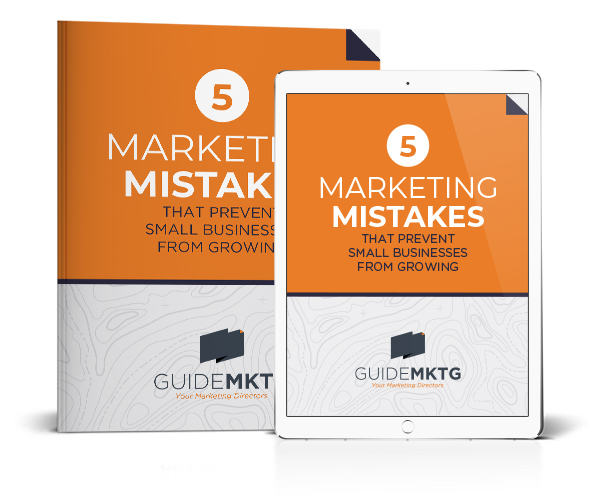Does marketing ever feel like a cruel guessing game? You pour all of your best ideas into a new marketing campaign only to get…nothing. No results, no amazing ROI—just radio silence. If your marketing isn’t working, it might be time to take a step back and look at your company messaging, the true foundation of good marketing.
Why is messaging the foundation of good marketing?
Donald Miller, the CEO of StoryBrand often says, “People don’t buy the best products. They buy the products they can understand the fastest.”
Messaging is the filter you put information about your company through before presenting it to a potential customer so that they can easily understand what you do. You want to package your offer in a way that makes sense to your target market and speaks to their wants and needs. If you don’t explain your value proposition in your customer’s own language, they will tune you out from the beginning.
For example, if you are a roofer and your marketing materials focus on the difference between EPDM roofing and PVC roofing, your value proposition is communicating nothing but noise to your customers. They probably don’t know what those terms mean, and frankly, they don’t care.
However, if your brand narrative says something like, “Do you want a roof that will never leak?” you’ll have their undivided attention. That is a problem they understand and deeply want to solve.
What is clear company messaging?
Clear company messaging uses a proven messaging framework to grab potential clients’ attention by putting them into an interesting story where they hold the leading role. Once potential customers are on the edge of their seats, wondering how it will all turn out, you’ll be able to explain the key benefits of your offering, why they need it, and how they can get it for themselves.
When we create clear company messaging for clients, we use the SB7 messaging framework, which includes these seven elements:
The Character
If you want a marketing strategy that works, you need to know who you are targeting. Who do you want to work with? Who is your ideal client?
If you’ve been in the business world for more than 30 seconds, you’ve probably created, or at least heard of, the client avatar exercise. Although I am in favor of defining some basic demographic information, the most important pieces to nail down are your buyer persona’s thoughts, feelings, and pain points related to what your company offers.
You need to know what your ideal client really wants and how your offering meets that need.
The Problem
Donald Miller says that “companies often sell solutions to external problems but people buy solutions to internal problems.”
Your clients may not all fit into the demographic boundaries you outline but they will all be unified by a problem that they want to solve. If you focus your brand narrative on the thoughts, feelings and struggles related to that problem, your marketing message will be much more effective.
I assure you that literally any company, in any industry, can connect their offering to the thoughts, feelings and pain points of their potential customers.
Let’s go back to our roofer example. Which marketing message makes you want to pick up the phone and call?
- “Are you embarrassed by the leak buckets adorning your living room? Your social life has suffered long enough. Call 222-4444 for a leak-free roof today.”
- “Need a new roof? Call 222-4444 today!”
When your brand promise shows that you understand how customers feel and what they really want, you build trust with potential clients. They are more likely to do business with you, over your competitors, because you’ve got the secret sauce. This messaging framework positions your company brand as the one who gets it.
A Guide
Your business is always the guide.
I know that probably seems a little counterintuitive. If you are going in to solve a client’s problem, shouldn’t you be the hero? After all, you’re the one showing up to save the day.
Although you can view your work like that, your communication needs to present your company as the guide.
We all see ourselves as heroes. When we are out searching for solutions to problems, we don’t want another hero. We want a guide—someone who will help us save the day.
So, instead of focusing on how amazing your business is, stay focused on how effectively you can help your potential customers overcome their problems and experience success.
Give them enough proof points to prove you can get the job done well, like client testimonials, listing a few credentials and awards or showing off your four-star Google rating, but keep the main focus on your customers.
A Plan
Oddly enough, just telling someone that you have a product or service that could solve their problem isn’t enough to get them to take action.
You see, no matter how wonderful your offering is, for consumers, opening up our wallets is risky. We want to be sure that we are spending our hard-earned money on something that is 100% worth every cent.
You have to show clients how simple it is to work with your company and reassure them that you can solve their problems for good using a clear plan.
Our roofer’s plan might say:
“Follow these three simple steps to get a leak-free living room by next week:
- Schedule a free consultation.
- Choose a sturdy new roof with a lifetime guarantee.
- Admire your living room’s new bucket-free look.”
A Call to Action
At this point in the messaging framework, it’s time to ask customers to take the next step. This is called your call to action, or CTA. A CTA should be a simple, short statement telling your potential client exactly what they should do next.
In our roofer example, their CTA is to schedule a free consultation. Other examples of CTAs are:
- Schedule a call
- Sign up for the workshop
- Download your free guide
- Book your assessment
- Make your appointment
- Buy your [product name] now
Notice that the goal of the CTA is not always to close a sale.
Especially with higher-cost products and services, your goal is generally just to get the prospective client to take the next step up the sales ladder. If you don’t explicitly ask customers to take the next step, though, they won’t do anything at all.
The Outcome
This last piece is essentially two elements of the messaging framework rolled into one. You want to show your clients what success could look like but you also want to remind them that failure is still lurking around the corner.
However, you don’t want to use these two elements equally in your marketing. Let’s pretend that marketing is like baking cookies. The success would be the sugar—you don’t want to skimp on that one. The sweetness of cookies is the best part!
The failure, on the other hand, is the salt in the recipe. You want just enough to help the cookies rise but not so much that you can actually taste the salt in the finished product. Salty cookies will send ideal clients running.
In your message development, mention success every chance you get. Then, occasionally sprinkle in reminders that if potential clients don’t take action, things will stay the same. They will still struggle with that same pain point unless they decide to work with you. You don’t have to use scare tactics or get all doom and gloom. Just a little hint here and there is enough. Remember, use a cup full of sugar and just a sprinkle of salt.
How to use clear company messaging
Once you’ve got clear company messaging, you’ll want to use it as a filter for everything.
All your internal stakeholders should know about the messaging framework. It should be the sales pitch that you give potential clients, the elevator pitch you use at cocktail parties, the company description on your social media profiles, and the core of all your marketing materials.
Clear company messaging will help you focus on what matters to your ideal client and leave out what doesn’t. When you talk to your prospective clients about your business in a way that makes sense to them, you will be able to create marketing campaigns that get results.
If your current marketing materials are falling flat, schedule a call with Guide MKTG today. We will write your clear company messaging and provide you with a solid marketing foundation that gets you results for years to come.





